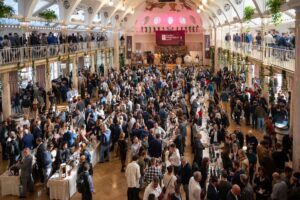
Italian wines are also the history of many families. Sometimes, the stories are, literally, fairy tales. For instance, the stories in the “Pentamerone”, or “Lo cunto de li cunti. Trattenemiento de peccerille”, a collection of 50 fairy tales narrated over 5 days, by Giovan Battista Basile, published between 1634 and 1636 in Naples (which Benedetto Croce called “the richest and most artistic of all popular fairy tale books”). And now, the descendants of the author, led by his namesake, Giovan Battista Basile, at the helm of Basile Cantina Biologica), are celebrating him, in Cinigiano. Their winery is one of the gems in Montecucco (and Basile is also president of the Consortium, ed.). To honor the work of his homonymous ancestor, he has produced a limited edition of Ad Agio 2007, dedicated to Petrosinella, to whom we owe codifying the fairy tale as a literary genre. The project is called “Petrosinella. A family history”, and links the masterpiece of his homonymous ancestor, “inventor” of the fairy tale, to him, a vigneron in Montecucco. Therefore, Giovan Battista started with a commissioned painting inspired by one of author Basile’s stories, and has put it on the label that will accompany one of his wines in a limited edition.
“The aim of the project”, Basile explained, “is to keep alive the cultural path of “Lo cunto de li cunti”, which is a collection of fifty fairy tales written by Giovan Battista Basile based in seventeenth-century Naples, to which we can trace the first written publication of this literary genre. It develops the contamination between wine and art, typical of the Basile nature, and the proof is that Elena, sister of the winemaker, preceded her brother to Tuscany and opened her farmhouse, Le Pianore a holistic ecosystem at the foot of Monte Amiata”. The stories in “Lo cunto” came from the popular oral tradition and then Basile enriched them using his classical and baroque skills. They are organized according to the typical elements of the Boccaccio novel, except that the various situations and characters are imaginary. Giovan Battista “the winemaker” followed this text to strengthen his bond with the family that left Naples more than twenty years ago and produce, halfway between Monte Amiata and Maremma, wines that are becoming more and more appreciated by consumers and critics.
The illustration that will accompany the 24 Magnums of Ad Agio 2007 has been made using the gouache technique and colored pencils on paper. It depicts Petrosinella, a girl identified by the tufts of parsley that have grown on her chest because of a spell Orca, the antagonist of the story, put on her. Behind the girl, surrounded by floral motifs, we can see other symbolic characters of the fairy tale - a lion and a wolf - which the protagonist will have to face in order to break the spell. The face, as well as the black hair of the young woman, was inspired by the drawing of the Neapolitan artist, Vincenzo Gemito, “Gypsy” in 1885.
The label was created by Giovanni Anastasia, a Neapolitan artist born in 1987, who trained at the Academy of Fine Arts in Naples. He was very interested in drawing and painting, so he approached sculpture by training in art shops in the city. He has collaborated with many visual artists, performers, video makers and musicians, and has been an integral part of the Palomart Network since its origins, where he participates in collective events and exhibitions. 2018 was the year of Fauna, his first solo show, hosted by the Bellini theater in Naples, where he exhibited paintings and sculptures, inspired by an animal and fairy-tale world.
The project, “Petrosinella. A family history” shines even more light on a territory in extraordinary growth: Montecucco. Bottling data for the first 3 months of 2020 compared to 2021 marked + 20%, thanks also to wine criticism that has perceived the growing quality of this denomination anchored to Sangiovese (as James Suckling confirmed last January, awarding several Montecucco wines scores higher than 90). The Montecucco denomination, whose Consortium counts 68 member companies and 500 claimed hectares (out of 800 potential), is 85% certified organic production, and its export share is 60%. “Montecucco is still an uncontaminated gem. We have always practiced sustainable viticulture in our vineyards — where we find some of the lowest ever yields; that is, 70 quintals of grapes per hectare. Our territory is naturally suited to the cultivation of vines, olive trees and other crops, because of the proximity of the Tyrrhenian Sea, which gives constant, dry winds, and being protected by Monte Amiata”, Basile explained. A fairytale-like territory, like him and like those fairy tales from which the Basile Winery created the cultural project.
Copyright © 2000/2025
Contatti: info@winenews.it
Seguici anche su Twitter: @WineNewsIt
Seguici anche su Facebook: @winenewsit
Questo articolo è tratto dall'archivio di WineNews - Tutti i diritti riservati - Copyright © 2000/2025